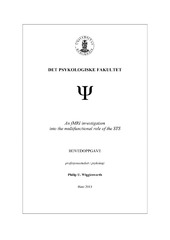| dc.contributor.author | Wigglesworth, Philip Ullring | |
| dc.date.accessioned | 2014-02-10T08:32:43Z | |
| dc.date.available | 2014-02-10T08:32:43Z | |
| dc.date.issued | 2013-11-25 | eng |
| dc.date.submitted | 2013-11-25 | eng |
| dc.identifier.uri | https://hdl.handle.net/1956/7771 | |
| dc.description.abstract | The superior temporal sulcus (STS) has been implicated subserving speech perception, audiovisual integration, and theory of mind. Prior functional imaging studies have also reported that distinct neuronal patches within the STS region show overlapping activation in response to these three cognitive processes. This finding has led to a theory that the STS as whole, or at least parts of it, are crossmodal and multifunctional in nature, subserving multiple and different processing demands based on network connectivity. The multifunctional role of STS was investigated by applying an fMRI mixed block- and event-related design, in which 20 participants were tested on three paradigms; speech perception, audiovisual integration, and theory of mind. Data was analysed using one-way ANOVA. Individual analysis of each contrast showed activation within the STS region for all three paradigms, with speech perception and audiovisual integration activating a large bilateral posterior STS area, and theory of mind activating bilateral middle and anterior STS areas. Global conjunction analysis revealed conjunct activation in the bilateral posterior STS area, though greater in cluster size in the right hemisphere, and showed a second discrete left middle-posterior STS activated patch. The results are on the whole in line with previous research, and indicate that the posterior STS area subserves crossmodal integration and that distinct sub-structures of the STS might be multifunctional in their processing ability. This is briefly discussed in relation to the theory of network connectivity. | en_US |
| dc.description.abstract | Den superiore temporale sulcusen (STS) er blitt funnet til å betjene taleoppfattelse, audiovisuell integrering, og ´theory of mind´ prosessering. Tidligere funksjonelle avbildningsstudier har også rapportert at forskjellige nevronale substrukturer inni STS viser overlappende aktivering i respons til disse tre prosessene. Dette funnet har ledet flere innenfor feltet til å foreslå at STS som helhet, eller i hvert fall deler av den, er kryssmodal og multifunksjonell ved at den tilsynelatende betjener ulike prosesseringskrav på bakgrunn av mer omfattende nevronal nettverkstilkobling. Den multifunksjonelle rollen til STS ble undersøkt i dette studiet med fMRI metodikk. Designet av studien var et blandet blokk -og event-relatert design, og studien inkluderte 20 deltakere. Det eksperimentelle utformingen bestod av tre betingelser: taleoppfattelse, audiovisuell integrering, og ´theory of mind´. Dataen ble analysert med enveis ANOVAs. Individuell analyse av de tre betingelsene viste aktivering innenfor STS regionen for alle tre paradigmer. Resultatet viste at taleoppfattelse og audiovisuelle integrering aktiverte et stort bilaterale posteriort STS område, mens ´theory of mind´ aktiverte mer begrensede bilaterale midtre og anteriore STS områder. En global kombinasjonsanalyse (´conjunction analysis´) av de tre betingelsene viste kombinert aktivering i det bilaterale posteriore STS området, med noe mer omfattende aktivering på venstre side, og noe begrenset aktivering i det venstre midtre-posteriore STS området. Resultatene fra studien er i tråd med tidligere forskning, og indikerer samlet sett at det posteriore STS området betjener kryssmodal integrering og at forskjellige substrukturer innenfor STS kan være multifunksjonelle i sin prosesseringsevne. Dette blir også diskutert i forhold til teorien om nevronal nettverkstilkobling. | en_US |
| dc.format.extent | 1501224 bytes | eng |
| dc.format.mimetype | application/pdf | eng |
| dc.language.iso | eng | eng |
| dc.publisher | The University of Bergen | eng |
| dc.subject | fMRI | eng |
| dc.subject | STS | eng |
| dc.subject | Crossmodal | eng |
| dc.subject | Speech perception | eng |
| dc.subject | Audiovisual integration | eng |
| dc.subject | Theory of mind | eng |
| dc.title | An fMRI investigation into the multifunctional role of the STS | eng |
| dc.type | Master thesis | |
| dc.rights.holder | Copyright the author. All rights reserved | |
| dc.description.localcode | PSYK300 | |
| dc.description.localcode | PRPSYK | |
| dc.subject.nus | 736102 | eng |
| fs.subjectcode | PSYK300 | |
